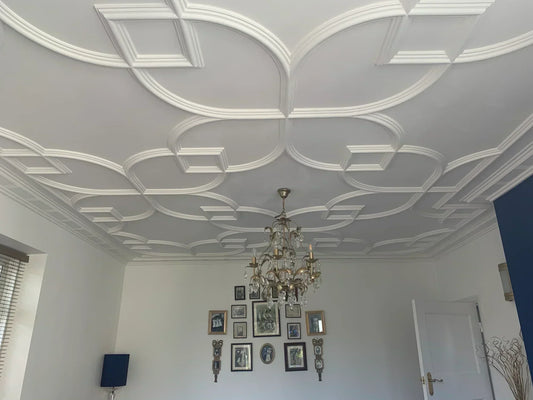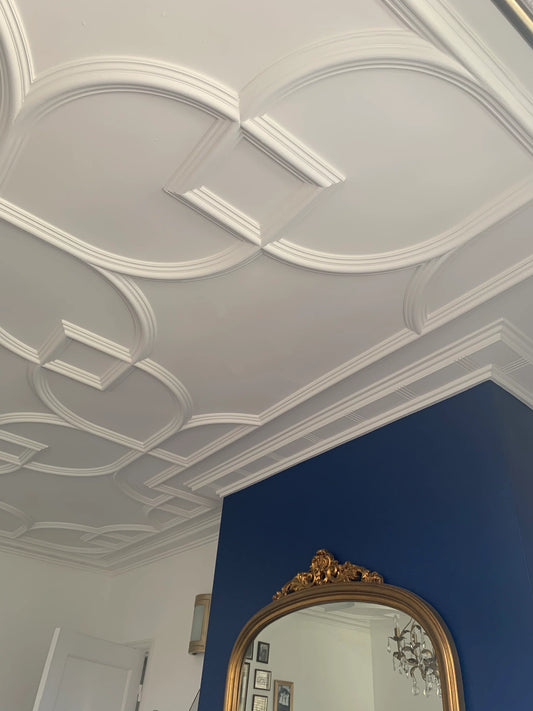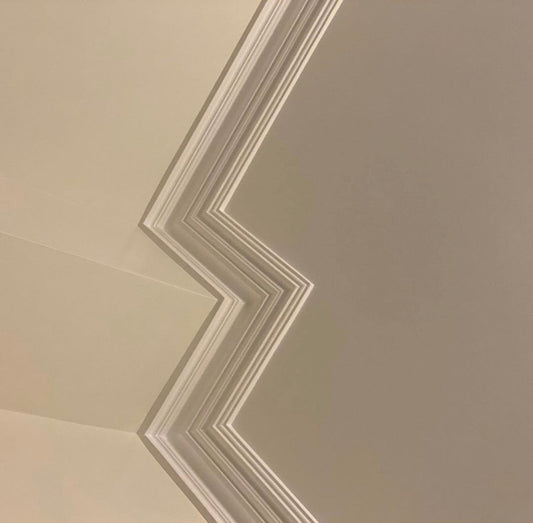When selecting coving for a construction or renovation project, material choice is crucial. Did you know that polyurethane coving can last up to 30 years or more with little to no maintenance? However, while polyurethane coving has gained popularity due to its lightweight nature and ease of installation, it does not match the durability, finish, or long-term performance of traditional plaster. Plaster has been the industry standard for centuries, offering superiority when it comes to lasting home upgrade materials.
In this guide, we’ll take a closer look at polyurethane coving, breaking down its features, advantages, common uses, and how it stacks up against other materials like traditional plaster, giving you the full picture to make an informed decision.
What is Polyurethane Coving?
Polyurethane coving is a type of decorative moulding used where walls meet ceilings, adding a smooth transition between spaces. Unlike traditional plaster coving, polyurethane coving is made from a lightweight polymer that provides sharp edges and lines of plaster while offering several added benefits. Typically, it’s faced with high-quality paperboard, making it ideal for painting without the need for priming. This makes it a popular choice for those who want a clean, professional finish with minimal effort.
While Keaney’s specialises in high-quality plaster mouldings, polyurethane coving offers an alternative solution for projects requiring a lightweight and cost-effective option that can look nearly as good.
Overview of Polyurethane Material
Polyurethane is a highly versatile plastic material that can be moulded to meet the needs of a wide range of applications. It’s known for its flexibility, toughness, and resistance to wear and tear, making it a great cheaper choice for industries ranging from construction to automotive. Polyurethane’s cellular structure gives it both flexibility and durability, which is why it’s increasingly used in interior design for coving and other mouldings. Its moisture resistance and ability to withstand impact damage make it ideal for environments where humidity is prominent. However, despite its practical advantages, polyurethane cannot replicate the authentic weight, detail, and durability of plaster.
How Polyurethane Coving is Manufactured
Polyurethane coving is produced through a modern process known as injection moulding, where liquid polyurethane is injected into pre-made moulds to create a desired shape. Once cured, the mouldings are hardened and ready for use. The resulting product is not only durable but also retains any details, making it an excellent substitute if plaster coving isn’t available. This manufacturing process also ensures consistency in quality and dimensions, providing a perfect fit every time.
Key Limitations of Polyurethane Coving
Lack of Authentic Detailing
Polyurethane coving is mass-produced using moulds, which can create sharp lines but lacks the depth and character of traditionally crafted plasterwork. Plaster is hand-finished, allowing for intricate designs and finer details that polyurethane simply cannot achieve. This is particularly important in period properties or high-end interiors where authenticity matters. Plaster has a subtle softness that allows it to achieve finer details, which looks particularly graceful with plaster ceiling roses.
Surface Finish and Paint Adhesion
While polyurethane coving is designed to be painted, it often requires additional preparation to achieve a smooth, professional finish. The material does not absorb paint in the same way as plaster, which means achieving a seamless, high-quality result can be more difficult. Plaster, with its natural surface texture, provides a superior base for paint application, enhancing the overall aesthetic.
Moisture and Chemical Resistance
Polyurethane’s resistance to moisture makes it suitable for environments with high humidity. It can be used in bathrooms, kitchens, and even outside, where water levels fluctuate significantly. Its chemical resistance also ensures that it maintains its appearance and strength, even in areas exposed to cleaning agents or other chemicals. However, unlike plaster, which maintains its structural integrity over time, polyurethane is susceptible to expansion and contraction with temperature changes. This movement can lead to visible gaps at joints, requiring additional maintenance and repairs. Plaster, in contrast, is stable once installed and does not shift or warp.
Common Applications of Polyurethane Coving
Residential Settings
Cornice and coving are frequently used in homes to add an advanced finish to living rooms, bedrooms, hallways, and kitchens. Polyurethane coving’s resistance to moisture makes it particularly useful in bathrooms and kitchens. However, properly installed and sealed plaster coving performs just as well in kitchens and bathrooms, offering a more refined and durable solution without compromising on craftsmanship.
Commercial and Industrial Environments
In commercial and industrial settings, where walls and ceilings are often subjected to more wear and tear, polyurethane coving offers a durable, long-lasting solution. Its resistance to impact and moisture ensures that it can withstand the demands of busy environments such as offices, hotels, and retail spaces.
Hygienic and Healthcare Uses
Polyurethane coving is also well-suited for use in healthcare environments, such as hospitals and research labs, where cleanliness and hygiene are paramount. Its smooth, non-porous surface resists bacteria and mould growth, making it easier to maintain sanitary conditions. This makes it a practical choice for environments that demand strict hygiene standards.
On the other hand, plaster’s smooth, non-porous surface naturally resists bacteria and mould growth, making it easy to maintain in sterile conditions. Unlike synthetic materials, plaster does not degrade over time or release harmful compounds, ensuring a stable, long-term solution for environments that require the highest hygiene standards.
Comparing Polyurethane Coving to Other Materials
Polyurethane vs. Plaster Coving
Plaster coving is a classic choice for those seeking a traditional finish. It offers excellent details and can be customised to match intricate designs. It also is resistant to shrinking, shifting and warping with temperature changes, that can sometimes occur with synthetic materials. Polyurethane, on the other hand, offers a similar look but is lighter weight.
While Keaney’s specialises in plaster coving, which is considered the premium option, polyurethane provides a lower-maintenance alternative.
Polyurethane vs. Wood Coving
Wood coving adds a natural warmth to a room, but it is susceptible to warping, rotting, and pest damage, especially in humid environments. Polyurethane, by contrast, is moisture-resistant and immune to these issues, making it a more practical choice for areas exposed to moisture. Additionally, polyurethane doesn’t require the same level of maintenance as wood.
Polyurethane vs. PVC Coving
PVC coving is another lightweight option, but it lacks the strength and durability of polyurethane. PVC can become brittle over time, especially when exposed to extreme temperatures or UV light. Polyurethane, on the other hand, maintains its structure, making it a better long-term investment. PVC also doesn’t offer the same level of detail in design, while polyurethane can mimic the intricate patterns of traditional materials.
Things to Consider Before Choosing Polyurethane Coving
Pricing and Budget
Polyurethane coving tends to be more affordable than plaster or wood, making it an attractive option for budget-conscious projects. However, it may not provide the same premium feel as high-quality plaster moulding.
Environmental Considerations
Polyurethane is a synthetic material, so its environmental impact is a consideration. However, it's not as eco-friendly as plaster, which is made from natural gypsum.
Why Traditional Plaster is the Better Investment
Exceptional Durability
Plaster coving has been used in construction for centuries and, when installed correctly, can last indefinitely. Unlike polyurethane, which may become brittle over time, plaster retains its strength and structure. Its solid composition makes it more resistant to accidental damage and general wear, making it ideal for high-traffic environments.
Seamless Installation
While polyurethane is often promoted as an easy-to-install material, achieving a high-end result requires significant preparation and adhesive work. Plaster coving, when installed by skilled craftsmen, offers seamless integration with walls and ceilings, with no visible joints or gaps. This results in a cleaner, more professional finish.
Architectural Authenticity
For heritage restoration projects or high-end interior design, plaster is the only material that delivers true architectural authenticity. It allows for custom mouldings, bespoke designs, and a level of craftsmanship that cannot be replicated with synthetic alternatives. Whether restoring a Victorian cornice or installing a modern decorative profile, plaster provides the precision needed for high-quality finishes.
Conclusion
While polyurethane coving may serve as a cost-effective alternative, it does not match the quality, durability, or authenticity of traditional plaster. Plaster remains the superior material for those seeking long-term performance, fire resistance, and a refined aesthetic. Keaneys specialises in expert plaster mouldings, ensuring that every project benefits from the highest standards of craftsmanship. For those looking for coving that lasts, plaster is the clear choice.
Whether you’re renovating a home, designing a commercial space, or working in a specialised healthcare environment, polyurethane coving can be a good option for a quick upgrade. For a more professional, sleeker finish, we recommend using traditional plaster materials.





